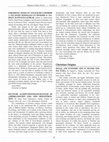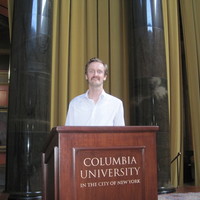Books by Beth Stovell
Co-authored with Beth M. Stovell. Cascade Companions; Eugene, OR: Cascade, 2022

Theodicy and Hope in the Book of the Twelve, 2021
This volume explores the themes of theodicy and hope in both individual portions of the Twelve (b... more This volume explores the themes of theodicy and hope in both individual portions of the Twelve (books and sub-sections) and in the Book of the Twelve as a whole, as the contributors use a diversity of approaches to the text(s) with a particular interest in synchronic perspectives. While these essays regularly engage the mostly redactional scholarship surrounding the Book of Twelve, there is also an examination of various forms of literary analysis of final text forms, and engagement in descriptions of the thematic and theological perspectives of the individual books and of the collection as a whole.
The synchronic work in these essays is thus in regular conversation with diachronic research, and as a general rule they take various conclusions of redactional research as a point of departure. The specific themes, theodicy and hope, are key ideas that have provided the opportunity for contributors to explore individual books or sub-sections within the Twelve, and the overarching development (in both historical and literary terms) and deployment of these themes in the collection.
Book Reviews by Beth Stovell
Journal of Hebrew Scriptures, Jan 1, 2010
This monograph is a revision of Bergmann's dissertation thesis at the University of Chic... more This monograph is a revision of Bergmann's dissertation thesis at the University of Chicago. As Bergmann's title indicates, her work focuses on the metaphor of childbirth as it is attested in writings from the ancient Near East, the Hebrew Bible, and Qumran. While Bergmann maintains ...
Journal of Hebrew Scriptures, Jan 1, 2010
... Angel, Andrew R., Chaos and the Son of Man: The Hebrew Chaoskampf Tradition in the Period 515... more ... Angel, Andrew R., Chaos and the Son of Man: The Hebrew Chaoskampf Tradition in the Period 515 BCE to 200 CE (LSTS 60; New York, London: T&T Clark, 2006). Pp. ... As Angel explains,. TheChaoskampf is the battle of the warrior god with the monstrous forces of chaos. ...
McMaster Journal of Theology and Ministry, 2009
Papers by Beth Stovell
BRILL eBooks, Jul 9, 2018

This chapter examines the kingship metaphors in the "triumphal entry" in John 12. Schol... more This chapter examines the kingship metaphors in the "triumphal entry" in John 12. Scholars generally agree that kingship metaphors are in John 12. It demonstrates how the extensive use of kingship metaphors in John 12 fits with the trajectory of kingship already established thus far in John's Gospel and fits with John's overall purpose of revealing Jesus' true identity with all of its ramifications. The chapter uses the idea of contested authority as a means of revising past interpretations that tended towards an apolitical interpretation of Jesus' kingship, and suggests a more nuanced view of the socio-political implications of Jesus' kingship based on kingship metaphors. It examines linguistic factors creating cohesion and prominence in John 12 with particular attention on the role of metaphors. The chapter also examines the blending of familial, judicial, and royal metaphors in John 12.Keywords: Jesus' true identity; John 12; John's Gospel; kingship metaphors

Religious Studies Review, Mar 1, 2016
Pp. 552; figures. Paper, e34.90. Family and friends of the late classicist Isabelle Ratinaud-Lach... more Pp. 552; figures. Paper, e34.90. Family and friends of the late classicist Isabelle Ratinaud-Lachkar offer this wide-ranging collection inspired by her view that the course of metal, from mine to merchant, offers a privileged window into society and culture (14). Twenty-three essays are grouped into four broad thematic sections inspired by the research interests of the honorand: metals, metalworkers and luxury goods (I); funerary practices (II); the city (III) and travel and cross-cultural contacts (IV). Ratinaud-Lachkar published widely on Argos and early Greece; these subject areas form the core of the volume with contributions by leading francophone Homerists, historians, and archaeologists such as Franc oise L etoublon (metals in Homeric formulae and the Hesiodic myth of the ages), Marcel Pi erart (the cult of Phoroneus at Argos), and Franc ois de Polignac on the conquest of Tiryns. The remaining essays range widely not only in time ("from Homer to our day") but in thought and space, from the land beyond the west wind (Castiliglioni on the ancient "Hyperborean route") to a Hellenistic Greek sanctuary in Afghanistan (Martinez-Sève). Medieval, Renaissance, and modern historians will want to scan the table of contents for other small gems such as a study of Ludovico di Varthema's journey to Mecca in 1503 (Martel-Thoumian), sixteenth-century Wunderkammern (Ghermani), iron mining in the Basse Marienne region of Savoie from the Middle Ages to the industrial revolution (Judet), and the idea of "Italy" among post-WWII French intellectuals (Forlin).

This chapter examines the use of kingship metaphors in Jesus' trial before Pilate, his crucif... more This chapter examines the use of kingship metaphors in Jesus' trial before Pilate, his crucifixion, and the description of these events as fulfillment of Scripture in John 18-19. It demonstrates the consistency of the vision of kingship between John 18-19 and must be necessarily understood as ironic, the overall portrayal of Jesus as truly king is never fully undermined. Moreover, Jesus' kingship is frequently emphasized by the use of this dramatic irony. This section argues that 1) Jesus' kingship is characterized by the comfort and justice he displays, 2) that the necessary response to this kingship is a discipleship that characterized by the cross, and 4) Jesus' crucifixion and anticipated resurrection demonstrate the already-not yet nature of God's kingdom. In John's Gospel, Jesus' exaltation occurs in his crucifixion, in his resurrection, and in a future eschatological expectation as well. Keywords:crucifixion; Jesus'; John 18-19; John's Gospel; Kingship; Pilate

This chapter introduces an interdisciplinary metaphor theory that incorporates elements of lingui... more This chapter introduces an interdisciplinary metaphor theory that incorporates elements of linguistic and literary theories to provide greater insight into the use of metaphor in biblical texts and, for the purposes of this study, in the Fourth Gospel specifically. This chapter also serves the methodological groundwork for the remainder of this study. Towards this end, the study of metaphor in the three areas of philosophical, linguistic, and literary analysis provides a reason for the use of linguistic and literary elements in the metaphor theory proposed in this study, and propose a theoretical basis for an interdisciplinary metaphor theory that incorporates elements of past theories in a new configuration. The final section provides a step-by-step description of the proposed linguistic-literary approach. In this way it is possible to demonstrate the necessity and impact of kingship metaphors on the Fourth Gospel as a whole. Keywords:Fourth Gospel; linguistic; literary; metaphor theory; philosophical











Uploads
Books by Beth Stovell
The synchronic work in these essays is thus in regular conversation with diachronic research, and as a general rule they take various conclusions of redactional research as a point of departure. The specific themes, theodicy and hope, are key ideas that have provided the opportunity for contributors to explore individual books or sub-sections within the Twelve, and the overarching development (in both historical and literary terms) and deployment of these themes in the collection.
Book Reviews by Beth Stovell
Papers by Beth Stovell
The synchronic work in these essays is thus in regular conversation with diachronic research, and as a general rule they take various conclusions of redactional research as a point of departure. The specific themes, theodicy and hope, are key ideas that have provided the opportunity for contributors to explore individual books or sub-sections within the Twelve, and the overarching development (in both historical and literary terms) and deployment of these themes in the collection.